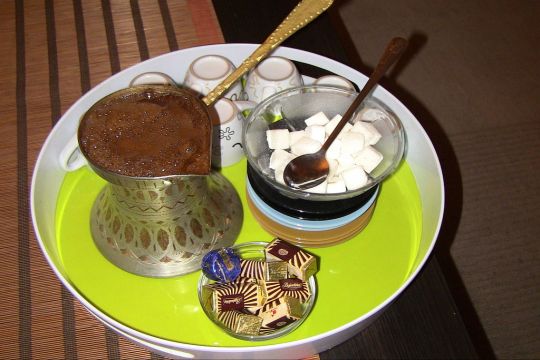|
Croatian Cuisine In many ways, Croatia is at the crossroads showing the influence of the Latin, Slav, Byzantine and Finno-Hungarian worlds. Croatian gastronomy is a reflection of the cultural mosaic of the country that is the gateway to the Balkans, the place where central Europe and the Mediterranean intersect, and a land that remains deeply Slavic despite its ties to Latin Rome. There are a number of different Croatian cuisines which can be grouped according to three main regions: Mediterranean cuisine, the continental cuisine of the Northern Plains, and the unique creations of the islands.
|
 Mediterranean CuisineOn the Adriatic coast, the Croatian cuisine has Mediterranean accents and revolves around grilled or poached fish. Olive oil, garlic, and plenty of herbs and spices are present in most dishes. The principal hors-d'oeuvre is Prsut (dried ham) served with goat cheese and olives. Local dishes include calamari salad, squid-ink risotto, Ston oysters, mussels or scampi à la bouzzara (prepared with bread crumbs, garlic, parsley, wine and olive oil), fish in brodetto (fish soup) or à la gregada (a kind of bouillabaisse), Pag goat cheese marinated in oil, and rozata (a variation of crème caramel). Dalmatian prosciutto is very hard and distinctly red and should be eaten in a traditional tavern with cheese and olives, or even simply a slice of fresh baked bread. In Split, the tiny fishing boats and nets hung out to dry in the port bordering the Diocletian Palace is a reminder of the many generations of sailors who have lived here.  The Continental Cuisine of the Northern PlainsIn the Northern Plains you will mostly find charcuterie products, stuffed cabbage, peppers and the rich pastries that are esteemed in this region. The culinary art of continental Croatia combines Hungarian, Austrian and Eastern influences. Hungary's influence is seen in wine or rabbit-based goulash, meat or cheese-filled dumplings and various desserts such as poppy seed cheesecake. Spices, ground meat seasoned with onions and garlic stuffed (cevapcici, pleskavica) or cooked on a spit, such as raznici are the Ottoman legacy. Besides breaded dishes and cabbage, Austrian influence is clearly seen in pastries: strudel, cream puffs, doughnuts, and cakes that are rolled, filled or layered with walnut paste. Favorite vegetables are potatoes and cabbage, which are sometimes preserved in vinegar, following the ancient method, and a regional specialty is visovacka begavica, lamb cooked in sheep's milk. Other local specialties include mlinci - flat, slightly sour dumplings that are served with turkey; and noodles with truffles from the forest.  Island CuisineMany Croatian islands specialized in unique foods. Korcula and Hvar Islands specialize in roast octopus, honey biscuits and wines made from ancient indigenous sorts of grapes such as prè. On the island of Pag they make a very firm goat's cheese called "paski-sir". Its unique flavor comes from the fact that the cheese is rolled in ashes and olive oil before ripening; what's more, local grazing pastures include lots of wild herbs, including sage and the cheese taste reflects it. The Island of Brac lays claim to having the country's protected cake, hrapocosa, covered with walnuts with a slight taste of rum.   |
 Everyday FoodThe day's main meal usually consists of meat or fish, potatoes and rice or corn. In coastal regions, a mid-morning break is observed for a light meal called "marenda," consisting of fish, cheese and bread.  CoffeeCoffee is traditionally served as espresso, very strong and in small cups. You can order double espresso (dupli espresso) or dugi or duzi espresso (long or longer). Everywhere in Croatia you will find traditional coffee houses similar to those in Vienna.  RakijaThe drink rakia or rakija is hard liquor similar to brandy and vodka, made by the distillation of fermented fruits, popular throughout the Balkans. The clear drink has a normal alcohol content of 40%, but home-produced rakija can be stronger, typically 50-60%. Rakija is considered to be the national drink among some of the South Slavic peoples: in Bosnia and Herzegovina, Bulgaria, Croatia, Montenegro, Republic of Macedonia and Serbia. Its most common form, slivovica, is produced from plums. Other commonly-used fruits are grapes (the most common in Bulgaria), peaches, apricots, juniper, apples, figs, and quinces. Plum and grape rakija is sometimes mixed after distillation with other ingredients, such as herbs, honey, sour cherries and walnuts. Each fruit serves a different flavor of rakija.  Beer and WineBeer is much appreciated by Croats, although wine is the drink most commonly served with meals. The oldest beer, called Osjecko, was first brewed in 1697, and can still be found in some stores. While beer remains popular, the countryside, especially the Dalmatian islands and Peljesac peninsula seem made for wine. The viticulture is not new, it was brought here by the Greeks. Spirits are also widespread, and many are home brewed. The most popular drinks are grape and herb-flavored brandies, sherry and wines such as Dingaè, Postup, Slahtina, Vgava, Posip, Marastina, Malvazija and Grk. |
|
Dubrovnik | Split | Trogir | Plitvice Lakes | Klapa Music | Silk Cocoons | Hvar Island | Mostar | Water and Wine | Books |





